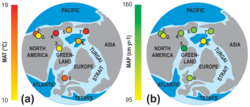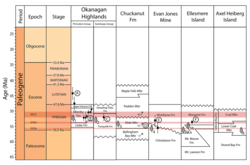| Margaret Formation | |
|---|---|
| Stratigraphic range: Wasatchian | |
| Type | Formation |
| Unit of | Eureka Sound Group |
| Overlies | Mount Moore Formation |
| Thickness | 140 m (460 ft) |
| Lithology | |
| Primary | Sandstone |
| Other | Siltstone, coal, tuff |
| Location | |
| Coordinates | 78°42′N81°54′W / 78.7°N 81.9°W |
| Approximate paleocoordinates | 76°06′N30°42′W / 76.1°N 30.7°W |
| Region | Ellesmere Island, Northwest Territories, Nunavut |
| Country | Canada |
| Extent | Sverdrup Basin |
The Margaret Formation is a geologic formation of the Eureka Sound Group in the Sverdrup Basin in Northwest Territories and Nunavut, Canada. The unit belonging to the Eureka Sound Group which crops out at Ellesmere Island preserves fossils dating back to the Early Eocene period, or Wasatchian in the NALMA classification. [1]
Contents
- Description
- Dating
- Arctic climate of the Early Eocene
- Fossil content
- Mammals
- Birds
- Reptiles
- Amphibians
- Fish
- Correlations
- See also
- References
- Bibliography
The Margaret Formation comprises sandstones, sandy siltstones, clay-rich sandstones, coal seams and clay-rich coal seams and volcanic ash beds. The thickness of the formation, which overlies the Mount Moore Formation, reaches about 140 metres (460 ft). Radiometric dating of the formation provided ages of 52.6 ± 1.9 Ma (2010) and 53.7 ± 0.6 Ma (2017).
The area where the formation was deposited in the Early Eocene experienced a much warmer climate than the High Arctic today, with mean annual temperatures ranging from 7.6 to 12.9 °C (45.7 to 55.2 °F) and warmest month mean temperatures from 18.2 to 22.2 °C (64.8 to 72.0 °F). The deltaic to swamp environment of the Margaret Formation has provided a diverse fauna of various groups of mammals, birds ( Presbyornis and Gastornis ), reptiles (turtles, snakes, lizards and crocodiles) and fish.









